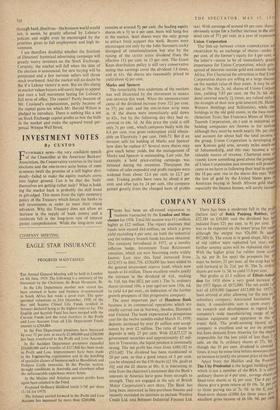INVESTMENT NOTES
By CUSTOS •
AVOURABLE news-the very confident speech r of the Chancellor at the American Bankers' Association, the Conservative victories in the local elections and the one-in-two scrip bonus of JOHN SUMMERS (with the promise of a still higher divi- dend)-failed to make the equity markets move into higher ground. Can it be that the 'bulls' themselves are getting rather stale? What is hold- ing .the market back is probably the dull trend in gilt-edged. This stems from the tight monetary policy of the Treasury which forces the banks to sell investments in order to meet their rising advances. Why the Treasury does not allow an increase in the supply of bank money and a moderate fall in the long-term rate of interest passes comprehension. While the long-term rate remains at around 5+ per cent. the leading equity shares on a 31 to 4 per cent. basis will hang fire in the market. Steel shares were the only group to attract fresh support this week. Buyers were encouraged not only by the John Summers cocky disregard of renationalisation but also by the raising of the GUEST KEEN dividend from the effective 11+ per cent. to 13 per cent. The Guest Keen distribution policy is still very conservative seeing that earnings cover the dividend 3.8 times, and at 61s. the shares are reasonably priced to yield about 41 per cent.
Marks and Spencer
The remarkably firm undertone of the markets was well illustrated by the movement in MARKS AND SPENCER this week. When the announcement came of the dividend increase from 321 per cent. to 371 per cent. and the one-in-four scrip issue in 'A' the shares were immediately sold down to 62s., but by the following day they had re- covered to 64s. 3d. At this price the yield is still only 3+ per cent., which compares badly with the 6.4 per cent. true gross redemption yield obtain- able on Electricity 3 per cent. 1968-73. But if an investor sells his holding of Marks and Spencer how does he replace it? Several store shares may give much better yields, but the management of Marks and Spencer is outstanding. Last year, for example, a bold price-cutting campaign was initiated during the recession. Thereupon the volume of sales expanded and profit margins were widened from about 12.4 per cent. to 12.7 per cent. Trading profits have risen by about 6 per cent, and after tax by 24 per cent. (the company gained greatly from the changed basis of profits tax). With earnings of around 69 per cent. there I obviously scope for a further increase in the divi• dend rate of 37+ per cent. in a year of expansion Union Corporation The link-up between UNION CORPORATION and CHARTERED by an exchange of shares-under 111 per cent. of the former's equity for 4 per cent. 0 the latter's-seems to be of immediately great importance for Union Corporation, which gets spread of interests outside gold and outside Soul Africa. For Chartered the attraction is that Unio Corporation shares are selling at a large discou on the market value of their assets. It may be so that at 59s. the 2s. 6d. shares of Union Corr o tion, yielding 5.85 per cent. on the 3s. 6d. di dend covered nearly 21 times, are valued only the strength of their new gold interests (St. He le Western Holdings and Stilfontein), while th holdings in the old gold mines, in the base met (Selection Trust, San Francisco Mines of Mex Tsumeb Corporation, etc.) and in industrial a holding companies are thrown in for nothi although they must be worth nearly 30s. per sha and account for about half the total income the group. Union Corporation is developing new Kinross gold area, seventy miles south-ea of Johannesbu'rg, and this may become a ver) valuable source of revenue. Chartered must 01' viously know something good about the prospec „ of Union Corporation and investors will prot abll come to no harm in following their lead in spite the 18 per cent. rise in the shares this year. Whtt the loss of gold by the United States goes on American buying in South African gold share4 especially the finance houses, will surely increa0


































 Previous page
Previous page